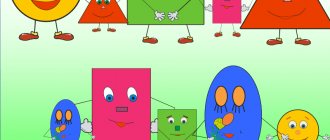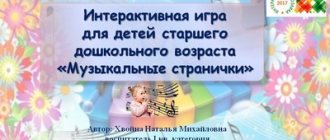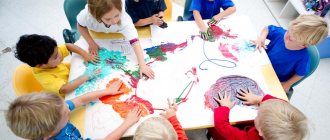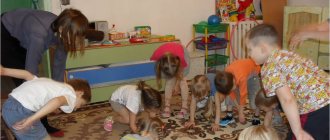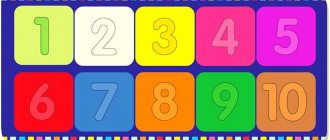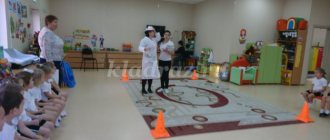Communication is the ability of a person to express his thoughts and feelings so that they are correctly understood by other people. A child, entering this world, from a very early age begins to communicate with adults and children, expressing himself in one way or another. And in order for this communication to take place in the most favorable conditions, it is important to teach the child to communicate correctly. The easiest and most effective way to teach children is through play.
Communicative play for children involves joint activities, self-expression and mutual cooperation, development of communication skills and the formation of friendly relationships. During these games, the child experiences genuine joy with other children, which later turns into cheerfulness, optimism, the ability to get along with other people, the ability to overcome life’s difficulties and achieve goals.
The lack of communication skills leads to a delay in the child’s mental development, and in the future – to the formation of a negative life position.
With these games, children:
- Body clamps are removed;
- There is an emotional release;
- Imagination, facial expressions and gestures develop;
- Attention is activated;
- Skills of rules of conduct are demonstrated;
- Self-esteem increases.
Books
If you want to understand in more detail the topic of developing children’s communication skills, pay attention to the following books:
- “Development of communication abilities in preschool children” Larisa Chernetskaya.
- “Communication with difficult children” Anton Makarenko.
- “Pedagogical poem” Anton Makarenko.
- “Development of communication abilities and socialization of children of senior preschool age” Svetlana Konovalenko, Maria Kremenetskaya.
- “Developing memory with a neuropsychologist” Anastasia Suntsova, Svetlana Kurdyukova.
- "Don't growl at the dog!" Karen Pryor.
- “How to talk so that children will listen, and how to listen so that children will talk” by Adele Faber, Elaine Mazlish.
We wish you good luck!
Did you like the article? Join our communities on social networks or our Telegram channel and don’t miss the release of new useful materials: TelegramVKontakteFacebook
We also recommend reading:
- Storytelling
- How to communicate with anyone, anywhere?
- Exercises for the brain. Part two
- Development of communication skills
- Play therapy when working with children
- How to motivate a child to read?
- Positive therapy for children
- Development of communication skills
- How to teach a child to read: rules, tips and tricks
- Top 5 most important soft skills for every child
- A selection of courses for children and parents
Key words:1Children
Explanatory note The ability to build and maintain good interpersonal relationships allows us to have broad social connections, loyal friends and a happy family. Developing children's abilities to build these relationships can help prevent the development of problems such as interpersonal conflict and loneliness. The manual “Communicative Games” is a collection of games that are aimed at the formation and development of communication skills in preschool children. The quality of relationships with other people of an adult depends on how successfully it is possible to form and consolidate communication skills in the mind of a preschooler. The manual is intended for use in preschool institutions.
Communication games from 3 to 5 years
Tiger hunting (authors: E. Karpova. E. Lyutova) Goal : development of communication skills. Age: 4-5 years. Number of players : at least 4 people. Necessary equipment: small toy (tiger). Description of the game: children stand in a circle, the driver turns to the wall, counts loudly to 10. While the driver counts, the children pass the toy to each other. When the leader finishes counting, the child who has the toy covers the tiger with his palms and stretches his arms forward. The rest of the children do exactly the same. The driver must find the tiger. If he guessed right, then the one who had the toy becomes the driver. You can train children in the ability to restrain emotions and not show them outwardly. This is quite difficult for preschool children. Mirrors Purpose: development of observation and communication skills. Age: 4-5 years. Number of players: group of children. Game description: the leader is selected. He stands in the center, the children surround him in a semicircle. The presenter can show any movements, the players must repeat them. If the child makes a mistake, he is eliminated. The winning child becomes the leader. Comment: it is necessary to remind children that they are a “mirror” of the leader, that is, they must perform movements with the same hand (leg) as him. PASS THE BALL Goal. Reduce excessive physical activity. In a circle, sitting on chairs or standing, the players try to pass the ball to their neighbor as quickly as possible without dropping it. You can throw or pass the ball as quickly as possible, turning your back in a circle and putting your hands behind your back. You can make the exercise more difficult by asking children to play with their eyes closed or with several balls at the same time. GAWMAN Target. Develop voluntary attention, speed of reaction, develop the ability to control your body and follow instructions. All players walk in a circle, holding hands. At the leader’s signal (the sound of a bell, a rattle, clapping hands, some word), they stop, clap their hands four times, turn and walk in the other direction. Anyone who fails to complete the task is eliminated from the game. The game can be played to music or a group song. In this case, children should clap their hands when they hear a certain (pre-agreed) word of the song. Touch... Goal: development of communication skills, ability to ask, removal of bodily pressures. Age: 4-5 years. Number of players: 6-8 people. Necessary equipment: toys. Description of the game: children stand in a circle and put toys in the center. The presenter says: “Touch ... (eye, wheel, right leg, tail, etc.).” Those who have not found the required item drive. Comment: There should be fewer toys than children. If children's communication skills are poorly developed, conflicts may develop in the initial stages of play. But in the future, with systematic conversations and discussion of problematic situations with moral content, including this and similar games, children will learn to share and find a common language. Aw! (authors: O. Khukhlaev. O. Khukhlaeva) Goal: development of interest in peers, auditory perception. Age: 3-4 years. Number of players: 5-6 people. Description of the game: one child stands with his back to everyone else, he is lost in the forest. One of the children shouts to him: “Ay!” - and the “lost” person must guess who called him. Comment: the game indirectly stimulates children's interest in each other through the game rule. This game is good to use in the process of introducing children to each other. It is easier for a child with his back to everyone else to overcome communication barriers and overcome anxiety when meeting others. WHO WAS BIT BY THE MOSQUITO? Goal: to promote the development of mutual understanding between children. Children sit in a circle. The leader walks along the outside of the circle, strokes the children’s backs, and quietly pinches one of them, unnoticed by the others—“bites him with a mosquito.” A child who has been “bitten by a mosquito” must tense his back and shoulders. The rest look at each other carefully and guess “who was bitten by the mosquito.” TWO TOYS - LET'S SWAP PLACES Goal: development of motor dexterity, attention, coordination of movements, cooperation. Description of the game: children stand in a circle, and the leader simultaneously throws toys to two players, who must quickly change places. Commentary: The game is played at a fairly fast pace to increase its intensity and difficulty. Moreover, it is still quite difficult for preschool children to perform actions of different directions (as in this game - catch a toy, see the one who got the second one and change places with him). INFLATE, BUBBLE Goal: developing a sense of cohesion, developing attention. Description of the game: children stand in a circle very closely - this is a “deflated bubble”. Then they inflate it: they blow into fists placed one on top of the other, like a pipe. After each exhalation, they take a step back - the “bubble” increases, after taking a few breaths, everyone joins hands and walks in a circle, saying: Inflate, bubble, inflate big, Stay like that, but don’t burst! It turns out to be a big circle. Then the teacher (or one of the children chosen by the leader) says: “Clap!” - the “bubble” bursts, everyone runs up to deflate) or scatters around the room (bubbles scatter). LISTEN TO THE TEAM Goal. Develop attention and voluntary behavior. The music is calm, but not too slow. Children walk in a column one after another. Suddenly the music stops. Everyone stops, listens to the leader’s whispered command (for example: “Put your right hand on your neighbor’s shoulder”) and immediately carries it out. Then the music starts again and everyone continues walking. Commands are given only to perform calm movements. The game continues until the group is able to both listen well and complete the task. The game will help the teacher change the rhythm of the actions of the naughty children, and the children will calm down and easily switch to another, calmer type of activity. Affectionate name Purpose: to develop the ability to make contact and pay attention to peers. Children stand in a circle, passing the baton (flower, “magic wand”) to each other. At the same time, they call each other by an affectionate name (for example, Tanyusha, Alyonushka, Dimulya, etc.) The teacher draws the children’s attention to the affectionate intonation. Echo Goal: to teach children to be open to working with others, to obey the general rhythm of movements. Children respond to the sounds of the leader with a friendly echo. For example, when the teacher claps, group members respond with friendly clapping. The presenter can give other signals: a series of claps in a certain rhythm, tapping on the table, wall, knees, stamping, etc. The exercise can be performed in a subgroup (4-5 people) or with the entire group of children. When performed in small subgroups, one subgroup evaluates the coherence of the actions of the other. Stand up and look at someone Goal: nurturing the partner’s feelings (communication through gaze). Progress: the presenter looks at one of the children. The child, catching his gaze, stands up. After this, they invite him to sit down. Who came to visit us? Purpose of the game: to teach children to switch their attention from themselves to others, take on a role and act in accordance with it. Age: from 3 years Game progress. At the beginning of the game, the presenter explains to the children that they will now welcome guests. The children's task is to guess who exactly came to visit them. From among the children, the presenter selects players, each of whom is given a specific task - to portray an animal. This can be done through gestures, facial expressions, and onomatopoeia. (The player portraying a dog can “wag his tail” - wave his hand from behind and bark, etc.). The players portraying animals come out to the children-spectators one by one. The audience must guess who exactly came to visit them, greet each guest warmly and seat him next to him. Boot Goal: to develop composure and independence in children, to cultivate attention to others, the ability to take them into account. Age: 4 – 5 years Game progress. At the beginning of the game, children line up at the starting line. The host offers to take a short trip. The children repeat the movements after him, simultaneously saying the words: Our legs, our legs We ran along the path. (children run towards the finish line) And we ran through the forest, Jumping over stumps. (children perform four jumps forward) Jump-jump! Jumping gallop! Lost your shoe! (children squat down and, placing their palm to their forehead, look right and left, looking for the “lost boot”). After this, the presenter says: “We found boots! Run home! Children run to the starting line, the game is repeated. Check of knowledge. Goal: to acquaint children with the habits of a pet, teach them to feel its needs, and empathize with it. Age: 4-5 years. Progress of the game. The presenter asks the child what the cat does if it is happy (purrs) and what if it is dissatisfied (arches its back, hisses). The presenter talks about the cat. The child’s task is to guess at what moments the cat will be happy (purr) and at what moments it will be angry (arch its back and hiss). Once upon a time there lived a cat named Murka. She loved to wash herself with her tongue (children pretend to be a “good cat”) and drink milk from a saucer (“good cat”). One day, the cat Murka left the house to go for a walk. The day was sunny, and Murka wanted to lie on the grass (“good cat”). And suddenly it began to rain heavily, and Murka got wet (“angry cat”). Murka ran home, but the rain fell harder and harder, and the cat ran into a small house standing in the yard. And in this house there lived a dog Sharik, he began to bark at Murka. What do you think Murka (“angry cat”) did? Murka got scared and started running. Having reached her house, Murka scratched at the door, and they immediately let her in (“good cat”). Murka warmed up and drank milk from a saucer. What do you think Murka did? Show me (“good cat”). Good elves Age: 4-5 years The teacher sits on the carpet, seating the children around him. Educator. Once upon a time, people, fighting for survival, were forced to work day and night. Of course, they were very tired. The good elves took pity on them. As night fell, they began to fly to people and, gently stroking them, lovingly lull them to sleep with kind words. And people fell asleep. And in the morning, full of strength, they set to work with renewed energy. Now we will play the roles of ancient people and good elves. Those who sit on my right hand will play the roles of these workers, and those on my left will play the roles of elves. Then we will switch roles. So, night came. Exhausted from fatigue, people continue to work, and kind elves fly in and lull them to sleep... Identify yourself Goal: learn to introduce yourself to a group of peers. Age: 3-5 years. Procedure: the child is asked to introduce himself by calling his name as he likes best, what he is called at home, or what he would like to be called in the group. Shop Goal: to develop the ability to express one’s thoughts accurately and concisely Age: 4-5 years One child is a “seller”, the rest of the children are “buyers”. Various items are laid out on the “store” counter. The buyer does not show the item he wants to buy, but describes it or tells what it can be useful for, what can be made from it. The seller must understand exactly what product the buyer needs. Whose subject? Purpose of the game: to teach children to show attention to other people. Age: from 4 years. Progress of the game: the teacher prepares several items in advance that belong to different children. Children close their eyes. The teacher waits for some time, giving the children the opportunity to calm down and concentrate, then asks them to open their eyes and shows an object that belongs to one of the children. Children must remember who this thing belongs to. The owner of the item should not give any hints. The game can involve items such as a hair clip, a badge, etc. Call affectionately Goal: to cultivate a friendly attitude among children towards each other. Age: 3-5 years. Progress: the child is asked to throw a ball or pass a toy to any peer (optional), affectionately calling him by name. Everything is the other way around. Purpose of the game: to teach children to identify actions that are opposite in meaning. Age: from 4 years. Progress of the game: using a counting rhyme, we choose the driver. Children stand in a circle, hands on their belts, the driver stands in the center of the circle. The driver makes voluntary movements and names them, the rest of the children perform the opposite actions. For example, the driver raises his hands up and says: “Hands up,” all the children lower their hands at their sides. A child who makes a mistake becomes the driver. If all the children perform the actions correctly, after a while a new driver is selected using a counting rhyme. Pines, fir trees, stumps Purpose of the game: to develop attentiveness and the ability to control one’s behavior. Age: from 4 years. Progress of the game: children stand in a circle, holding hands. The teacher is in the center of the circle. Quiet music plays and children move in a circle. At the teacher’s command “Pines”, “Fir-trees” or “Penechka”, children must stop and depict the named object: “Pines” - raising their arms high up, “Fir-trees” - spreading their arms to the sides, “Penechki” - squatting down. Players who make a mistake are eliminated from the game or receive a penalty point. Then the game continues.
Card index of communicative games at an early age card index (junior group)
CARD INDEX
COMMUNICATION GAMES
FOR EARLY CHILDREN
Only through specially organized training and education can significant success in the development of communication be achieved.
At the age of 2-3 years, communication with peers becomes increasingly important. This is due to the fact that there is meaningful communication between peers on equal terms, therefore:
- children strive to interest themselves and attract the attention of peers;
- respond sensitively to any action of a peer;
It is from the moment when interest in another child begins to show that children need to be taught to communicate with each other.
Let's consider several options for games aimed at developing communication skills in young children. The proposed games can be used in working with children with special educational needs.
These games are aimed at developing communication skills, the ability to receive joy from communication, the ability to listen and hear another person, the emotional sphere; relieving muscle and psycho-emotional tension, intensifying communication with each other and forming a positive attitude towards peers.
Greeting Games
Ritual of greeting "Sun"
Goal: creating a positive attitude in the group; develop the ability to use kind words when communicating with each other.
Progress of the game: It is carried out in the morning using the “Good Sun” toy. Children stand in a circle, holding hands. The use of a circle, as is known, is a guarantee of the protection of the one who is in it. The friendliness and warmth of the circle determine the general atmosphere of children's lives. Educator: Good morning, guys! Look, our Sunshine has been waiting for us and we really want to say hello and warm you with his warmth. Let's say hello to him. Whoever has the sun in his hands will call his name affectionately. But first, we will all say the magic words together and pass the sun from hand to hand, when the words end and whoever has our sun left in his hands, the game will begin. The sun walks in circles and gives its light to the children. And with light comes to us - Friendship - sunny greetings. You can also use the following emotional moods, which can be performed both in the morning and in the afternoon. “Sunny” Sunshine, sunshine, shine in the sky! (children stretch their arms upward and stand on their feet) Stretch out bright rays to us. (They stretch their hands forward, palms up) We will put our hands (break into pairs, extend their hands to each other) into your hands. Spin us around, lifting us off the ground. (They spin in pairs) Together with you we will go to the meadow (they line up in a chain, holding each other’s hands) There we will all stand together in a circle (form a circle) We dance in a circle with songs. The sun goes around in circles. (Walk in a circle) Our palms clap joyfully, (clap their hands) Frisky legs walk quickly. (They walk at a fast pace) The sun has disappeared, gone to rest (they crouch, cover their heads with their hands, then their hands under the cheeks) We will sit down with you (quietly, calmly sit in their seats) “Let's rejoice” Let's rejoice in the sun and the birds, ( children raise their hands up) And we will also rejoice at the smiling faces (Smile at each other) And everyone who lives on this planet (throw up their hands) “Good morning!” We will say together (hold hands) “Good morning!” - Mom and Dad “Good morning!” - will stay with us. Game "Good morning!"
Goals: creating a positive emotional climate in the group; relieving emotional stress and psychological barriers with the help of tactile sensations (touch).
Progress of the game. The adult, together with the children, chants the text: Good morning, little eyes! (touch your eyes with your fingertips) Are you awake? (claps hands) Good morning, nose! (touch the tip of the nose) Are you awake? (claps your hands) Good morning, ears! (touch both ears with your fingertips). You woke up? Good morning, little mouth! (we touch our lips with our index finger) Are you awake? Good morning, pens! (make “flashlights” with both hands) Are you awake? Good morning, tummy! (circular stroking of the palm of the hand on the tummy) Are you awake? (claps hands) Good morning, kids! Is everyone awake?! Let's reach for the sun! (hands up, stretch)
Games to form positive contacts with peers.
Game "Call kindly"
Goal: to cultivate a friendly attitude among children towards each other. Age: 3-5 years. Progress of the game: The child is asked to throw a ball or pass a toy to any peer (optional), affectionately calling him by name.
Game "Aw!"
Goal: development of interest in peers, auditory perception.
Number of players: 5-6 people.
Description of the game: one child stands with his back to everyone else, he is lost in the forest. One of the children shouts to him: “Ay!” - and the “lost” person must guess who called him. Comment: the game indirectly stimulates children's interest in each other through the game rule. This game is good to use in the process of introducing children to each other. It is easier for a child with his back to everyone else to overcome communication barriers and overcome anxiety when meeting others.
"A bird has flown"
Goal: develop attention to peers.
Material: toy bird.
Progress: the teacher shows the bird and performs actions in accordance with the text: The bird has flown, Little Titmouse. She flew to Lena (places the bird on Lena’s hand and the other children in turn). She looked at the children and then flew away.
"Hiding from the rain"
Goal: stimulate imitation of peers, develop the desire to stay together. Material: umbrella
Progress: the teacher attracts the attention of the children by showing a closed umbrella, and performs actions together with the children in accordance with the words: It started raining for a walk. Drip-drip-drip! Drip-drip-drip! /movement of fingers on palm/ Children’s feet will not get wet. /raise their legs/ The umbrella will gather them all, /opens the umbrella and spins it/ Will protect them from the rain. /everyone is hiding from the rain under an umbrella/ The teacher comments: “Everyone, everyone, everyone here. And Luda, and Sveta, and Vladik. Everyone is here... Come closer, come closer, otherwise everyone won’t fit under the umbrella.”
Game "Let's play together"
Goal: teach children to interact and treat each other politely.
Equipment: paired toys (ball-groove, train-car, car-cubes).
An adult distributes toys to children, places children in pairs, and invites them to play together. Then he helps each of the children perform object-based play actions in accordance with the purpose of each toy. At the end of the game, the adult records who played with whom, calling each child by name: “Anya played with Dasha - they rolled a ball, Dima played with Vasya - they drove a train, Petya played with Lena - they loaded and carried cubes in the car.”
Game "Our Sun"
Goal: to promote the unification and interaction of children in the group.
An adult draws a circle on whatman paper. Then he outlines the palms of the children, thus creating rays of the sun. With the help of an adult, children color the drawn palms. The result is a beautiful multi-colored sun that is hung in a group.
Game "The bird's wing hurts"
Goal: to promote in children the ability to love others.
One of the children turns into a bird whose wing hurts. He tries to show that he is sad. The presenter invites the children to “feel sorry for the bird.” The first to “pity” her is the presenter himself, who puts a baby doll on his hand and strokes the “bird” with its paws with the words: “The bird... (Sasha, Masha) is good.” Then other children put on the kitten doll and also “feel sorry for the bird.”
Game "Locomotive"
Goal: to teach the child to respond to his name, remember the names of peers, and act according to demonstration and verbal instructions.
The adult explains to the children that now they will play train. The main locomotive will be the adult, and the children will be the carriages. He calls the children one by one, emotionally commenting on what is happening: “I will be the locomotive, and you will be the carriages. “Petya, come to me, stand behind me, hold my belt, like this. Now Vanya, come here, stand behind Petya, hold him by the belt,” After all the children have lined up, the “train” sets off. An adult, imitating the movement of a steam locomotive “Chuk-chukh, oo-oo-oo!” encourages children to repeat them.
Games to overcome shyness.
Game "Affectionate Child"
Goal: continue to teach children to imitate emotional, tactile and verbal ways of interacting with a partner.
How to play: Children sit on chairs in a semicircle in front of an adult. He calls one of the children to him and shows how to hug him, lean against him, look into his eyes, and smile. “Oh, how good Sasha is, come to me, I’ll hug you, like that. Look, kids, how I hug Sasha, like this. I'm affectionate! Then the adult invites another child to his place and invites him to repeat all his actions, emotionally emphasizing each child’s action and, if necessary, providing him with help. At the end of the game, the adult emphasizes and sums up all the child’s actions: “Vanya hugged Sasha, looked into his eyes, and smiled. That’s what Vanya is, an affectionate child!” Then the adult calls the remaining children one by one and the game is repeated. Game "Roar, lion, roar!" This game is good to play with children suffering from stiffness and passivity. The adult says: “We are all lions, a big friendly family. Let's have a competition to see who can growl the loudest. As soon as I say: “roar, lion, roar!” let the loudest roar be heard.”
Game "Prickly Beast"
Purpose of the game: creating a positive mood in children, creating a friendly atmosphere. Age: from 3 years.
Progress of the game. The teacher shows the children a drawing of a mysterious animal made on a large sheet of paper. The whole beast is pricked with toothpicks stuck into the poster. The teacher explains that this is a very angry and terrible beast. He became like this for the reason that he has a lot of thorns on him, so everyone is afraid of him and does not want to play with him. The teacher asks the children to help this animal get rid of its anger and irritation. The children’s task is to take pity on the animal and reward it with good character traits. As soon as the child says a good word about this animal, the teacher pulls out one thorn from it and breaks it. Gradually, the number of thorns on the animal decreases, it takes on a very kind and cute appearance, and the children all come up with a nickname for it. It is desirable that the number of thorns be greater than the number of children, so that each child can contribute to the process of transformation of the beast from evil and prickly to good.
Game "Quiet and Loud"
The purpose of the game: to relieve emotional stress, to teach children to alternately change the rhythm of movements as directed by the teacher.
Progress of the game: Children playing stand in a circle. The teacher takes the tambourine in his hands, sits in the center of the circle and explains to the children the rules of the game, which are as follows: to the loud and frequent beats of the tambourine, the children actively move without leaving their place: they jump in place, stomp their feet heavily, wave their arms, etc. ., depending on the wishes of the child. When the tambourine hits become rare and weak, children reduce their activity and silently walk in place - sneaking, slowly and rising on tiptoes. At the beginning of the game, the teacher changes the rhythm at certain intervals, for example, after 3-4 minutes. Further, the game becomes more impulsive, the rhythms and force of the tambourine hits change frequently, at different intervals. Children must learn to suddenly change the pace of activities. The game can be played quite often, several times a week. When the children are well acquainted with the game, the teacher can offer the role of leader to one of the children, if desired. Game “Glue Stream” Goal: to develop the ability to act together and exercise self- and mutual control over activities; learn to trust and help those with whom you communicate. Conditions of the game: Before the game, the teacher talks with the children about friendship and mutual assistance, that together they can overcome any obstacles. Progress of the game. Children stand one after another and hold on to the shoulders of the person in front. In this position they overcome various obstacles. 1. Get up and get off the chair. 2. Crawl under the table. 3. Go around the “wide lake”. 4. Make your way through the “dense forest”. 5. Hide from wild animals. An indispensable condition for the guys: throughout the entire game they should not become detached from each other.
Game "Grandma Malanya"
Goal: development of non-verbal and substantive methods of interaction; creating a favorable atmosphere of direct, free communication and emotional intimacy.
How to play: Children hold hands and stand in a circle. The teacher portraying Malanya stands in the center of the circle. You can wear an apron or scarf on it. The guys walk in a circle and sing a funny song: At Malanya's, at the old woman's, Seven sons lived in a small hut, All without eyebrows. (Close your eyebrows with your hands) With ears like this, with noses like this, with a mustache like this, with a head like this, with a beard like this. (they show all this) They didn’t eat anything, they sat all day, (they squat down) they looked at her and did something like this... Then the children repeat after Malanya any funny movement that the child shows. (Horns, long nose, jumping, dance moves, squats, wagging a finger, crying as a joke, etc.) Game “Run, run, kids run quickly” Goal: develop the ability to listen and hear another person, the emotional sphere, remove the psychological barrier with the help of tactile sensations (touches). Progress of the game. The teacher pronounces words, accompanying them with movements. The children ran, ran quickly, and threatened each other. Don’t you dare fight. They clapped their hands and hugged each other tightly. They smiled at each other and held hands. (Then the words are repeated) The children try to repeat the teacher’s movements.
Game "Blowing Soap Bubbles"
Goals: to help children adapt to the conditions of kindergarten.
Objectives: creating a positive emotional climate in the group; relieving emotional stress. Material: soap bubbles.
Progress of the game: the teacher blows soap bubbles and says: Be careful, bubbles! Oh, what! Look! They're getting bloated! They sparkle! They're having a blast! They're flying! Here - with plum! Here - as big as a nut! It didn't burst for the longest time! Children catch soap bubbles.
Game "Blow up the bubble"
Goal: Create a favorable atmosphere in the group. Cheer up.
Progress of the game: The teacher says words, accompanying them with actions (spreads his arms to the sides). Blow up the bubble, Blow up big, Yes, don't burst. (At the last words he claps his arms outstretched.) Children try to repeat the actions of the teacher.
Game "Sunny Bunnies"
Goal: Relieving emotional stress. Creating a favorable atmosphere of direct, free communication and emotional intimacy.
Progress of the game: The teacher makes a sunny bunny on the wall with a mirror, directing the children’s gaze to it, pronouncing the words. The bunny jumped onto the window - Bright, nimble, mischievous. He sat there for a while, looked into my palm, climbed onto the ceiling... And he jumped: hop and hop. Children are trying to catch a sunbeam.
"Games aimed at overcoming aggression"
Game "Bunnies"
Goal: to give the child the opportunity to experience a variety of muscle sensations, to teach them to focus on these sensations, distinguish and compare them.
Progress of the game: An adult asks the children to imagine themselves as funny bunnies in a circus, playing imaginary drums. The presenter describes the nature of the physical actions - strength, pace, sharpness - and directs the children's attention to awareness and comparison of the muscular and emotional sensations that arise. For example, the presenter says: “How hard the bunnies beat on the drums! Do you feel how tense their paws are? You feel how firm the paws are and don’t bend! Like sticks! Do you feel how the muscles in your arms, even in your shoulders, have tensed?! But there is no face! The face is smiling, free, relaxed. And the tummy is relaxed. He’s breathing... And his hands are knocking tensely!.. And what else is relaxed? Let’s try knocking again, but slower, to catch all the sensations.” But there is no face! The face is smiling, free, relaxed. And the tummy is relaxed. He’s breathing... And his hands are knocking tensely!.. And what else is relaxed? Let’s try knocking again, but slower, to catch all the sensations.” In addition to the “Bunnies” exercise, it is recommended to perform muscle relaxation exercises.
Games for anxious children
"Balloon"
Goal: relieve tension, calm children. Progress of the game. All players stand or sit in a circle. The presenter gives instructions: “Imagine that now you and I will inflate balloons. Inhale the air, bring an imaginary balloon to your lips and, puffing out your cheeks, slowly inflate it through parted lips. Follow with your eyes how your ball becomes bigger and bigger, how the patterns on it increase and grow. Introduced? I also imagined your huge balls. Blow carefully so that the balloon does not burst. Now show them to each other
"Bear Cubs"
Invite children to turn into little bear cubs. “The cubs are lying in a den. A strong wind blew and made its way into the den. The cubs are frozen. They are curled up in balls, warming themselves. It got hot, the cubs turned around and growled.” The teacher tells the children about the bear cubs, the children imitate their movements. (The exercise is aimed at muscle relaxation).
"Dudochka"
Goal: relaxation of facial muscles, especially around the lips.
Progress of the game: The teacher says to the children: “Let's play the pipe. Take a shallow breath of air and bring the pipe to your lips. Start exhaling slowly, and as you exhale, try to stretch your lips into a tube. Then start over. Play! What a wonderful orchestra!”
"Humpty Dumpty"
Goal: relax the muscles of the arms, back and chest. “Let's put on another little performance. It's called "Humpty Dumpty". Humpty Dumpty sat on the wall. Humpty Dumpty fell in his sleep. (S. Marshak) First, we will turn the body left and right, while the arms dangle freely, like a rag doll. To the words “fell in my sleep,” we sharply tilt the body down.”
"Change of Rhythms"
Goal: to help anxious children join the general rhythm of work and relieve excessive muscle tension.
Progress of the game: If the teacher wants to attract the attention of the children, he begins to clap his hands and count loudly, in time with the clapping: one, two, three, four... The children join in too, all clapping their hands together, counting in unison: one, two, three, four... Gradually the teacher, and after him the children, clap less and less, counting more and more quietly.
